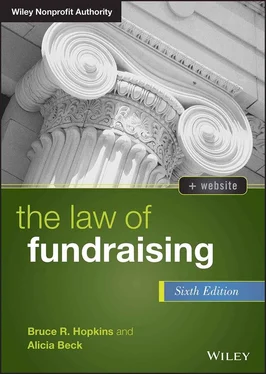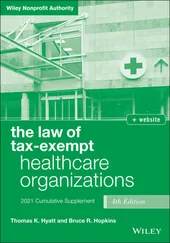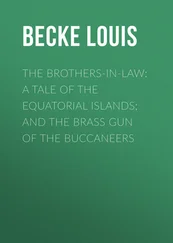Bruce R. Hopkins - The Law of Fundraising
Здесь есть возможность читать онлайн «Bruce R. Hopkins - The Law of Fundraising» — ознакомительный отрывок электронной книги совершенно бесплатно, а после прочтения отрывка купить полную версию. В некоторых случаях можно слушать аудио, скачать через торрент в формате fb2 и присутствует краткое содержание. Жанр: unrecognised, на английском языке. Описание произведения, (предисловие) а так же отзывы посетителей доступны на портале библиотеки ЛибКат.
- Название:The Law of Fundraising
- Автор:
- Жанр:
- Год:неизвестен
- ISBN:нет данных
- Рейтинг книги:4 / 5. Голосов: 1
-
Избранное:Добавить в избранное
- Отзывы:
-
Ваша оценка:
- 80
- 1
- 2
- 3
- 4
- 5
The Law of Fundraising: краткое содержание, описание и аннотация
Предлагаем к чтению аннотацию, описание, краткое содержание или предисловие (зависит от того, что написал сам автор книги «The Law of Fundraising»). Если вы не нашли необходимую информацию о книге — напишите в комментариях, мы постараемся отыскать её.
The Law of Fundraising
The Law of Fundraising
The Law of Fundraising — читать онлайн ознакомительный отрывок
Ниже представлен текст книги, разбитый по страницам. Система сохранения места последней прочитанной страницы, позволяет с удобством читать онлайн бесплатно книгу «The Law of Fundraising», без необходимости каждый раз заново искать на чём Вы остановились. Поставьте закладку, и сможете в любой момент перейти на страницу, на которой закончили чтение.
Интервал:
Закладка:
About one year later, another report speaks of the “transformative promise of online fundraising” that has yet to materialize. 30 This report looks at the “short history of online fundraising” and finds that it “is not without signs of progress.” It summarizes the successes of online-giving websites and notes that “[y]ear to year, more people give money online to charity.” Still, for most charitable organizations, this report states that online giving “represents a sliver of their overall fundraising.” The “promised revolution” is “moving at glacial speed” because of ancient tech infrastructure, reluctance on the part of fundraising management to place more emphasis on online operations, and lack of understanding by senior executives and board members of the potential of online fundraising. This report concludes that “effective online fundraising doesn't eliminate the human touch at the core of giving.” Every day, the report states, “you see more meaning and substance on the Internet, more people forging thoughtful, deep connections—deeper connections, perhaps than a professional fundraiser could ever hope for with a yearly newsletter.” 31
§ 1.3 BRIEF HISTORY OF GOVERNMENT REGULATION OF FUNDRAISING
“‘Helping’ Children” was the first line of a front-page Washington Post headline in 1980, which continued: “Va. Charity Raised Nearly $1 Million, but 93 Percent Went for Expenses.” 32 That headline, despite its age, encapsulates one of the prime issues facing America's philanthropic community today: the reasonableness of fundraising costs, as perceived by federal and state legislators and regulators and by the public—as well as those who manage or are generally responsible for the charities involved. Government regulation of fundraising for charity, while encompassing other matters, is fixed on the single issue of fundraising expenses: their measurement, reporting, and “proper” amount. 33 In fact, the origin of government regulation of fundraising is traceable to the fundraising cost issue; the history of this field of regulation reflects reaction to a pageant of alleged abuses by charities soliciting gifts, each of which featured an ostensibly “high” percentage of fundraising costs.
This article detailed the direct-mail fundraising activities of Children's Aid International (CAI), an organization headquartered in Alexandria, Virginia. According to the account, the organization raised nearly $1 million over a two-year period—“money it promised to spend on packages of high-protein food for malnourished children around the world”—yet expended on “food for children” less than seven cents out of each dollar raised. The breakdown on CAI's expenditures: 25 percent for management fees, 17 percent for other administrative costs, 51 percent for fundraising, and the balance—7 percent—for “starving children.”
The clear implication gained from the article is that a 93 percent fundraising cost experienced by a charity is “improper,” may be close to “fraudulent,” and is certainly “wrong.” The closest the article came to expressing criticism was its observations that CAI's fundraising costs are “high in comparison with … many established charities,” and that the fundraising costs of the local United Way agency are less than 7 percent. The organization's defense—unavoidably high startup costs—went unanalyzed and was buried deep in the story. It may be safely assumed that the article helped fuel public suspicion about charitable institutions generally.
Some months before, another Washington Post headline had announced: “Pallottines Say Nearly 75% Spent for Fund-Raising.” 34 This story featured the celebrated case of the Pallottine Fathers, a Catholic order based in Baltimore, Maryland, that conducted a massive direct-mail fundraising effort and allegedly devoted, in one 18-month period, 2½ cents out of every dollar received for missionary work. Apparently, in 1976, the order raised $7.6 million and spent $5.6 million to do so. This undertaking eventuated in a grand jury investigation, which developed evidence of extensive real estate dealings by the order and a loan to the then governor of the state to help finance his divorce. Little of the proceeds of the order's solicitations went to support Pallottine missions in underdeveloped countries as claimed. The publicity became so intense that the Vatican rector general of the order commanded that Pallottine fundraising activities cease and formed a special investigating commission; the priest who headed the order's fundraising operations was banished from Maryland by the archbishop of Baltimore.
Another well-publicized instance of this nature concerned the Freedom Forum International, Inc., formerly the Gannett Foundation. Although this matter did not involve fundraising costs, it focused on ostensibly high administrative expenses; the organization was under investigation by the office of the state attorney general in New York to determine whether these expenses were “imprudent or excessive.” A front-page Washington Post headline stated: “Neuharth Foundation Spares No Expense,” with an inside-page headline trumpeting that “Freedom Forum's Expenses Far Outstrip Its Contributions, Grants.” 35 According to this account, in 1991, the foundation incurred expenses of $34.4 million and made grants in the amount of $20.2 million. Office expenses were $17 million and a rooftop conference center accounted for $5.4 million; trustees' fees were higher than the norm, and the chairman's compensation was said to be “more than 10 times greater than is typical in large private foundations.” 36 The article related trips of the board of trustees to resort areas for meetings, air travel on first class, and payment of travel expenses of board members and some of their spouses. The newspaper concluded that the organization's “spending is unusual compared with similar-sized foundations—or even those twice or more its size—which … receive their funding from endowments, not from public donations.” 37
Another of these reports focused on the use of candy, gum, and other vending devices by charitable organizations as a fundraising technique. Apparently, the charities often receive small amounts of money in the form of licensing fees, while the vast bulk of the funds flows to those who sell and operate the devices. The arrangement spawned this front-page Washington Post headline: “For Charity, Just Drops in the Bucket,” followed by “Most of Public's Donations Go to Marketers, Vendors.” 38 Although one national charitable organization was said to have received 10 percent of the amount received from dispensers in 1992 ($1.4 million), many receive little or nothing in this fashion. When the charities own the devices directly or in partnership with a vending company, it seems that they regularly receive as much as 15 percent of the gross receipts. 39
Still another of these episodes, this one involving the Marine Toys for Tots Foundation, was splashed across the front page of the Washington Post : “Marines' Toys for Tots Spent Millions on Itself,” with the subheadline stating: “Donations Used to Run Charity, Not Buy Gifts.” 40 This organization was said to have “collected nearly $10 million in the last two years through a direct-mail campaign, but foundation officials acknowledge that none of the money has gone to buy toys for needy children.” 41 When contributions from other sources are taken into account, however, the report added, the three-year-old foundation expended 10 percent of the money raised in its most recent fiscal year for toys for children; the balance was spent on management, fundraising expenses, and promotional materials. The new head of the foundation was quoted as saying that “[m]y goal, and it is an optimistic one, is to have 75 percent of the money raised in the next mailing go toward program expenses, with most of that going to buy toys.” 42 Other program activities of the foundation included education of the public on the needs of poor children.
Читать дальшеИнтервал:
Закладка:
Похожие книги на «The Law of Fundraising»
Представляем Вашему вниманию похожие книги на «The Law of Fundraising» списком для выбора. Мы отобрали схожую по названию и смыслу литературу в надежде предоставить читателям больше вариантов отыскать новые, интересные, ещё непрочитанные произведения.
Обсуждение, отзывы о книге «The Law of Fundraising» и просто собственные мнения читателей. Оставьте ваши комментарии, напишите, что Вы думаете о произведении, его смысле или главных героях. Укажите что конкретно понравилось, а что нет, и почему Вы так считаете.












